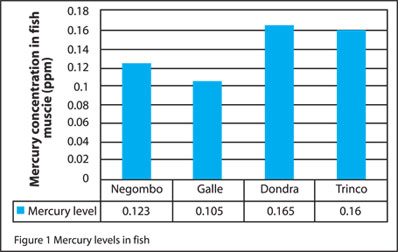Study to help tuna export business
Mercury levels in tuna fish examined:
Ramani Kangaraarachchi

 |
|
Malinda
Weththasinghe |
Malinda Weththasinghe is a final year student of the Uva Wellassa
University. He is an animal and nature lover since his childhood. An old
boy of Matara Rahula College, he developed a very useful research
related to fishing industry in the country, which is the distribution of
mercury in tuna fish (Thunnus albacares) in Sri Lanka in relation to its
habitat and size.
He believes that since the mercury levels in tuna fish may determine
the future of tuna exports to EU countries, further research on this
aspect needs to be considered seriously.
Reduction of mercury levels through value addition and reduction of
discharge of mercury into the sea by the industries may help to sustain
the industry.
Mercury is an element having different forms and is toxic to human
beings. Mercury is used in many industries for different purposes and
released to the environment with industrial wastage.
Mercury gets into waterways through waste disposal and ultimately
ends up in the sea where element mercury is converted into organic
mercury due to microbial action.
When this happens there is a possibility of fish absorbing the
mercury through bio-magnification.
Mercury gets accumulated in the human body due to consumption of such
contaminated fish and may have serious health problems.
Therefore, the EU market has imposed regulations regarding the levels
of mercury in fish.
However in Sri Lanka, research regarding mercury levels in tuna fish
has not been carried out yet.
This research is aimed to find the mercury distribution in tuna in
relation to the landing sites, different locations of the body of yellow
fin tuna.
The study was conducted in four landing sites; Galle, Trincomalee,
Dondra and Negombo.
It has revealed that there is a significant relationship between the
landing site and mercury level of fish.
Eastern coastal areas recorded higher mercury levels than the Western
coastal area.
 The mean mercury values are shown in the figure below. The mean mercury values are shown in the figure below.
According to the graph Dondra and Trincomalee recorded higher mercury
values than Galle and Negombo.
Dondra recorded the highest mercury level.
This may be explained well considering the flow of oceanic currents
as shown in the figure below.
The mercury released into the Indian Ocean by the highly
industrialized south eastern countries may flow to Dondra area with the
East Indian oceanic current.
Sometimes mercury which is deposited in the Bay of Bengal also comes
through the East Indian Ocean current.
Therefore the east coast area in Sri Lanka shows high mercury levels
than the west coast.
The study also revealed that the mercury levels increase with the
increase of body weight in fish but there are no specific locations in
the body of the fish where they get accumulated. The samples taken from
different locations in the body (head, under the pectoral fin and tail)
showed the same level of mercury.
|



